:: Monday, March 22, 2004 ::
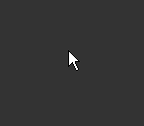
NEW.WRITING: Interview with Jan Robert Leegte
BY: Peter Luining
Jan Robert Leegte is a Dutch artist living and working in Amsterdam, the Netherlands. His work combines a sculptural approach to digitalmaterial with a deep interest in browser and Windows' aesthetics. What makes it stand out from other computer or Internet art is that it breaks away from the computer related experience. Leegte's installation work isolates elements of Windows' interface that in turn are projected onto various structures. This alienates the elements from their original function and makes them into familiar but also indefinable aesthetic objects.
Peter Luining: You started as a sculptor doing installations. What brought you to the internet?
Jan Robert Leegte: The world behind the computer screen has always fascinated me. (Probably since my dad occasionally brought a primal desktop computer home from the office back around 1980, shortly afterwards followed by the inevitable Commodore 64.) My actual real 'hands on' experience with the net came much later, but as soon as I saw the effects of my first HTML code in 1997, I was hooked.
PL: What influence does / did your background as sculptor have on the way you made work for the net?
JRL: The fact that I worked directly in source code was very important. I had some earlier experience with WYSIWYG software creating HTML files but this hadn't inspired me at all. It wasn't until I typed my first lines of HTML directly in a text editor that I
got interested. It had a totally different impact on me. When typing a code and seeing its effects later you address an existing object and command it to act in a certain way, after which you yourself have to move to its space to see what has happened. By using code you give a validation of autonomy to the final work. And in my case I would say even a physical validation. Code introduced me to a new environment in which I could create sculptural installation as I had done previously.
PL: In your work you still use elements of the classic Windows interface. It is even so that you started to rebuild whole parts of the classic interface for certain net art works in Flash, why?
JRL: [laughs] As long as Windows supports its 'classic' interface my first action on a new computer will be resetting the interface! It's a small inconsistent flaw in my work. The Microsoft interface has, as Umberto Eco called it, a "Protestant feel" to it in reaction to the Catholicism of the Macintosh interface. I would consider Windows' classic interface to be modernistic in comparison to the ornamented 'design' interface of Apple (I'm not mentioning the horrific attempt at design of Windows XP!). It's the functional form of Windows, the naive sculptural beauty you find in utilitarian factory architecture that inspires me. Or to be more precise, it fully embodies my research in sculptural experience through its plain and simple embossed chrome elements. I should add that I have kept the HTML studies on-line in their original unadapted state. Apart from the design and the earlier mentioned coding, a third aspect is the status generated by mass use. Because of the interface being taken for granted by millions of users in their daily use, it also gains physical validity. Therefore I keep the old works in HTML in spite of the aesthetic torture!
PL: Recently you shifted back from the net to installations in real space, why?
JRL: It took me some time, but at a point I started noticing aspects of interactivity and net-behaviour which I hadn't focussed on until then. My main field was exploring this space in which I could build these 'new' sculptural experiences and placing them on the net. I had been adding interactive experiments now and then, but they were side-tracks. When I began noticing how people react to browser based work and the way the net is used, I decided my research would have to find a different medium. The sculptural feel of the Internet studies is fragile and demands the viewer to look mainly as if observing a
phenomenon in nature. The net is a highly impatient, click- based environment. Visitors would sometimes interpret my work as an intentional aggravation for the user, a form of crash-art, or even subversive. I decided that it was the effect of the medium Internet
that created these unintended connotations. Shifting back to 'real' space was a very effective way of dispensing with this problem.
PL: Do you see any future in autonomous artworks specifically made for the internet?
JRL: Definitely. All forms of research in art demand an optimal instrument with which to communicate. The Internet has a very specific character. For many fields of art it is the perfect medium. I myself haven't discarded using the net since I have started doing spatial work again. In my view, the work which I put on show at the on-line exhibition of 'Abstraction Now' in Vienna definitely belongs on the net. Projecting it onto a wall in an exhibition space would most certainly reduce its impact.
http://www.leegte.org
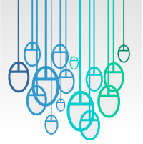
ORIGINAL POST: Tue Mar 16, 07:15:56 AM
BY: ana boa-ventura
With the traditional closing speech, Bruce Sterling invites everyone (and I mean everyone) for drinks at his place, as is his custom. However, another event will compete tonight with Sterling's demonstrated hosting abilities; The Austin Museum of Digital Art is doing its bimonthly showcase at its original location: the "old" dance club "Texture" downtown, now "Bonggo's." The showcase is not quite part of SXSW program but Harold Chaput and the rest of the folks behind it have been cleverly making one of its showcases happen during the mega event, and the hundreds of interactive art enthusiasts in town for SXSW are definitely pleased with that coincidence.
This year, the theme for SXSW was creativity. A lot of the panels were devoted to social networks, online communities. Blogs and wikis abounded on the list of panels. Brenda Laurel and Howard Rheingold's keynote speeches were definitely the highlights. Brenda developed the notion of "transmedia" that she is puts in place at the Art Center's Media Design Program of the Art Center College of Design (CA) and showed several of the best works produced by the graduate students she is supervising. At the end, she had a book signing for her newest "Design Research: Methods and Perspectives". I bought it, she signed it and i got to tell her how her "Computers as Theatre" changed my life (and it did).
I missed what was apparently one of the best panels of the meeting, "Virginia Postrel presentation." The economist of the New York Times, Postrel writes about the importance of aesthetics in everyday life in "The Substance of Style."
I got to go to another panel on aesthetics: "The aesthetics of social networks." Each panelist started by giving her/his own definition of aesthetics, and the discussion that resulted suffered more than gained from that diversity of definitions. Furthermore, in my opinion and of others whom I was able to talk to once the session was over, the "aesthetics" was confused with "representations of " social networks and, particularly, of social software. Although Molly Steenson stressed that social networks were well beyond social software, the panel as a whole didn't seem to have it very clear. Friendster and Orkut were, once again, the favorite topic of discussion. Danah Boyd focused on maps of relationships as one's representation. However, this is precisely the object of a whole body of study pointing at the negative aspects of online social networks that have taken place since the well-known Internet Paradox study (1). I will make it simple by translating these successive findings as "are we really building relationships or are we increasingly looking at our belly button?" Maybe Boyd didn't intend to go that far, but a brief mention as to how some scholars are looking at the negative aspects of this self-reflexivity would have been interesting.
To get back to the Austin Museum of DIgital Art bimonthly showcase, which takes place tonight at Bonggo's, the visual artists are (and notice the wonderful French-based Pleix Collective):
Brian Alfred
Bill Hundley
Sue Costabile (Musork, Reline DVD)
Eric Tomberlin
flora&fauna.visions
Ford Unstable Media
Ben Hodges
Robert Hodgin
Jeffers Egan
Takagi Masakatsu (Carpark Records)
PLEIX Collective
Nate Pagel (Designate)
re-move
Ryan Molloy
Min Kang
All in all, SXSW was wonderful as always. You should plan to come to Austin Texas next year!
Reference:
1) Kraut, R., Patterson, M., Lundmark, V., Kiesler, S., Mukophadhyay, T., & Scherlis, W. (1998). Internet paradox: A social technology that reduces social involvement and psychological well-being? American Psychologist, 53, 1017-1031
http://www.sxsw.com
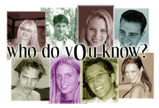
ORIGINAL POST: Mon Mar 01, 01:30:00 AM
BY: Peter Luining
Op nettime-nl vond de afgelopen week een interessante discussie plaats over google's nieuwste speeltje Orkut. Voor een beschijving ervan een kort citaat uit een stukje dat Karin Spaink erover schreef op netkwesties.nl: "Online vriendennetwerk Orkut heeft een waarlijk vliegende start gemaakt: drie weken na oprichting zijn zowat al mijn internettende vrienden al lid. Het wordt druk besproken, zowel op het net als in Het Echte Leven.
Het principe achter al die vriendennetwerken is simpel: je meldt je aan, zet een beschrijving van je interesses neer, geeft op wie je vrienden zijn, stuurt ze een uitnodiging en vormt al doende cirkeltjes. Vervolgens kun je bekijken wie de vrienden van je vrienden zijn of opzoeken wie er je interesse deelt. Met die vers gevonden mensen kun je vervolgens ook banden aanknopen. Heel gezellig en een geweldige manier om je tijd te verliezen. 't Heeft allemaal niet veel om het lijf, ook al is het natuurlijk erg leuk om een verloren gewaande kennis terug te vinden.
Maar Orkut is anders. Het kan - anders dan Friendster of al die andere online communities - rekenen op een forse dosis sympathie van de meer doorgewinterde internetters en groeit derhalve als kool. Dat Orkut hechte banden heeft met Google - Orkut is in bedrijfstijd gemaakt door een werknemer van Google - zal daaraan niet vreemd zijn: als Google zijn goedkeuring aan iets nieuws hecht, is dat nieuwe verschijnsel alleen al door dat stempel vanzelfsprekend vreselijk hip."
Het artikel ging vooral in op het privacy aspect, dat van alle kanten rommelde. In de nettime-nl thread onstonden er helaas 2 kampen. Het ene kamp vond dat je bewust moest zijn van de gevaren aangaande privacy (deze groep werd aangevoerd door Karin Spaink en Geert Lovink) en een andere groep die vonden dat de predikers van privacy toch wel te ver gingen als het ging om wat nu wel of niet te doen (Rosanne van Klaveren, Ine Poppe). Wat mij het meest bevreemde was de toon van de discussie, wat eigenlijk nog vreemder was omdat ik de felste bestrijder van het hele Orkut gebeuren (Geert Lovink) enkele dagen eerder was tegenkomen als Orkut lid. Goed, achteraf bekeken biedt de discussie die er op nettime.nl onstond zowel goede argumenten voor als tegen. Maar het beste van de thread blijft voor mij dat je in dit soort gevallen (uitnodiging voor een exclusieve gemeenschap) toch altijd eerst even moet nadenken voordat je toehapt want overal staan ondernemingen op de loer die iets van je willen.
Orkut thread op nettime-nl
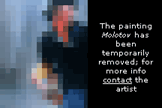
ORIGINAL POST: Sat Mar 13, 02:49:02 PM
BY: Eduardo Navas
The artist Joy Garnett may have a lawsuit against her for using a photo-journalist's image in her painting titled Molotov. What has followed after Garnett made her situation public is a deluge of appropriations and commentaries by net art communities (although Garnett is not revealing the names of the plaintiff or her lawyer -- we know the plaintiff is a woman). Joy Garnett recently updated her "webring" on the Rhizome Raw list; her original post can be found on Rhizome.org's thread: http://rhizome.org/thread.rhiz?
thread=12379&text=23895#23895 Because there currently is no website hosting all of this information. Net Art Review is supplying all the links, as updated by Joy Garnett.
click here for complete list.
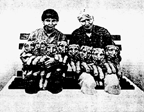
ORIGINAL POST: Mon Mar 15, 02:14:20 AM
BY: Peter Luining
Recently, several mailing lists were flooded with the support messages and actions for the Molotov painting by Joy Garnet (see post above by Eduardo Navas). Though I didn't read all of the responses (I'm not on all lists that commented on the Molotov case), the main thing I missed in all of the comments was that this whole type of copyright lawsuits have already had some clear precedents. The best known example of this type of case is probably Rogers vs Jef Koons, in which Rogers sued Koons for using his copyrighted image "Puppies" for the work "String of Puppies." Jeff Koons lost the case and it's interesting to know why. Here I quote from the article "COPYRIGHT PROTECTION AND APPROPRIATION ART" by William M. Landes:
"... is appropriation of mass media images by the artist Jeff Koons who was the defendant in three similar copyright cases in the 2nd Circuit. In the best-known case, Rogers v. Koons, the defendant purchased a note card displaying a photograph of a group of puppies with their owners, tore off the copyright notice from the card, and hired an Italian foundry to make four sculptures based on the photograph. Since Koons admitted copying, the only issue on appeal was if his copying was a fair use.
Counting against fair use is that Koons added little to the original image except for changing the medium and adding color. Indeed, altering the image would have defeated his purpose of changing the meaning of the image by putting it in a different context. On the other hand, Koons' sculpture is not likely to damage the market for the copyrighted photograph. The products are in different markets and won't compete for sales. Yet the plaintiff's business was licensing photographs so upholding Koons’ fair use defense could potentially eliminate an important source of revenue to photographers and result in adverse incentive effects.
Koons' principle argument for fair use was that his work should be privileged as a satirical comment or parody. By appropriating an everyday image, he claimed that his work commented critically on a political and economic system that places too much value on mass produced commodities and media images. Not surprisingly, the court rejected his defense because his work did not comment directly on the appropriated image. As noted earlier, fair use requires that the parody be directed at least in part at the original work. When the parody comments on society at large, the defendant should be able to license the copyrighted work."
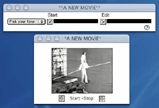 E X T E N D E D . F E A T U R E
E X T E N D E D . F E A T U R ENEW WRITING: no/copy/right
BY: Garrett Lynch
EXCERPT: no/copy/right is an online exhibition that has just been opened by no-org.net, a "new Jerusalem art network envisioned as a platform for experimental projects in the area of netbased and digital art and for the exchange of independent information on contemporary art."
Subsequent to a call for works on the theme of anti / counter copyright which went out through most mailing lists at the start of this year for a new net.art 'space' completely unknown to the community, I have been regularily checking the site to see how well the exhibition fared. It's a shame but many online exhibition ‘spaces’, which have had promising debuts, have not been in successive exhibitions or have quite simply been pushed out by the mainstream art world.
click here for the complete article.
"no/copy/right" by Garrett Lynch will be featured through 4 April 2004.